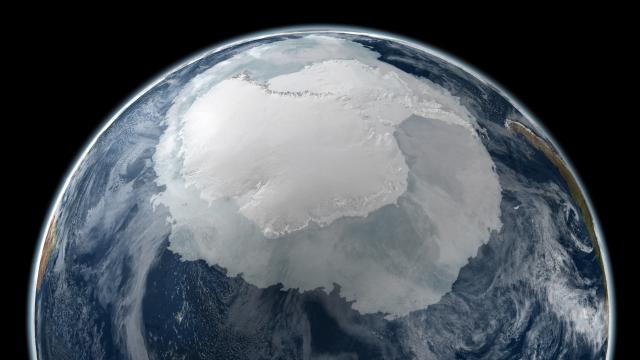A year and a half ago, in the middle of the Antarctic winter, satellite images of the frozen continent revealed something wild: A gaping hole in the middle of Antartica’s sea ice that spanned thousands of square kilometres. Scientists were fascinated and puzzled by feature, which hadn’t appeared at this scale since the 1970s. Now, a team of researchers think they know what caused it.
The ice hole — known as a polynya in the parlance of sea ice researchers — was likely caused by a powerful cyclone that spun up in Antarctica’s Weddell sea in mid-September 2017, according to research published this week in the Journal of Geophysical Research: Atmospheres.
In an age of human-caused climate change, that’s a valuable insight, because rising temperatures could alter the frequency or intensity of polar cyclones, potentially affecting the occurrence of these polynyas and, in turn, global ocean circulation.
When the polynya was first spotted in mid-September, it spanned about 9600 square km — more than twice the area of Rhode Island. It would balloon in size over the weeks to come, reaching 80,300 square km (roughly the size of Ireland) by late October before it merged with the open ocean as Antarctic sea ice retreated with the onset of summer.
The hole was, in a word, enormous, and it prompted a raft of speculation as to what could have caused it. The site of the polynya — directly above an enormous undersea mountain known as the Maud Rise — made it especially intriguing, as similar giant polynyas had been spotted in the same location in satellite imagery from the 1970s.
That’s likely no accident. As senior study author David Holland of New York University’s Abu Dhabi Research Institute explained to us by phone this week, the presence of the Maud Rise seamount — which he described as “the equivalent of the Himalayas” except underwater in a polar ocean — pushes the warm, dense, salty water that typically lingers near the seafloor closer to the ocean’s surface.
If a big storm rolls through, that can cause this warm water to mix with the cooler, fresher water floating atop the Weddell sea.
#Sentinel1 image (yellow frame: 30Sept17) shows #WeddellPolynya persistence, despite #Antarctic sea ice drift @ESA_EO @OSISAF @polarview pic.twitter.com/QG3aIoRQpV
— Mark Drinkwater (@kryosat) October 1, 2017
“And once you do that, you’ve upset the cart, and the warm water’s at the surface, and it’s gonna take months to cool” enough to freeze over again, Holland explained.
Using a combination of satellite observations and climate models, the researchers determined that the polynya’s opening coincided with a cyclone — roughly equivalent in strength to a powerful tropical storm — forming over the Maud Rise. The researchers think the cyclone’s winds pushed the ice outward from its centre, creating a hole that would continue to expand over the days to come.
Céline Heuzé, a physical oceanographer at the University of Gothenburg, Sweden, told us in a phone interview that other recent research has shown 2017 to be “quite an intense year in the Southern Ocean with respect to storm activity”.
While Heuzé said that the new study’s findings “make sense”, she’s keen to learn more about the role that the ocean plays, which is why she recently had a student trek out and deploy an “autonomous profiler” to measure temperature and salinity in the Maud Rise area.
Heuzé hopes there’s another polynya this winter, so that this instrument can capture any changes taking place in the ocean as it’s opening.
Torge Martin, a meteorologist and climate modeller at the Helmholtz Centre for Ocean Research in Kiel, Germany, told us via email that the study’s authors “make a valuable contribution to explaining the occurrence of the polynya, and they are correct in arguing that the atmospheric side has been less studied in the past”.
“This is because the preconditioning in the ocean is essential,” Martin wrote. “The regional atmospheric conditions then can be the trigger in a specific winter season.”
The idea that cyclones can trigger the polynya raises the possibility that it will crop up more often in the future, with rising temperatures expected to intensify polar cyclone activity. Climate change is also warming the oceans, potentially making it harder for the polynya to refreeze once it’s been opened.
This is worth exploring, Holland said, because the polynya’s delivery of ocean heat to the surface, followed by the sinking of that water as it becomes cooler and denser, plays an important role in global ocean circulation.
Changes to the polynya could, in other words, ripple outward across Earth’s oceans. As Heuzé put it, “everything’s connected.”
